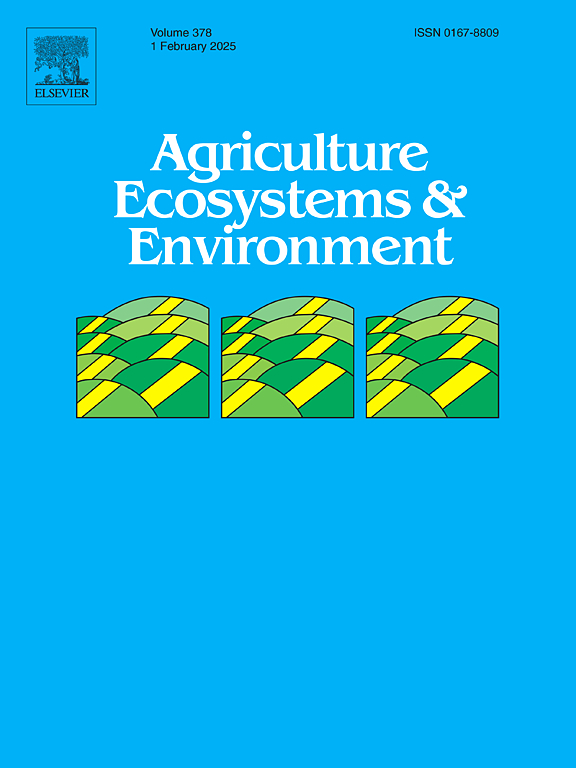Natural capital metrics as predictors of farm-scale richness of birds and plants
IF 6
1区 农林科学
Q1 AGRICULTURE, MULTIDISCIPLINARY
引用次数: 0
Abstract
There is increasing pressure for improved traceability through agricultural supply chains and for farmers to report on their natural resource use, environmental performance, and biodiversity management. Metrics or indices of natural capital are often used in sustainability reporting, but to be effective, they need to represent the condition and extent of natural capital assets present on a farm, and their capacity to support biodiversity at the farm scale – the scale at which many management decisions are made. We propose seven metrics to represent natural capital at the farm scale: (i) Ecological Condition; (ii) Woody Vegetation Cover; (iii) Aggregation (of woody vegetation); (iv) Proximity (of production areas to woody vegetation); (v) Soil Condition; (vi) Riparian Buffer Condition; and (vii) Forage Condition. To assess whether these metrics can represent biodiversity values, we tested the relationship between the metrics and empirical data on plants and birds collected from 1155 sites located across 50 farms (total farm area = 135,890 ha) in south-eastern Australia. Farm-scale species richness of woodland-dependent birds was best explained by the proximity of production areas to woody vegetation and the overall cover of woody vegetation on the farm. Ecological Condition was the strongest predictor of farm-scale richness for all plant species, native plant species, native ground cover and perennial ground cover species. While we demonstrated strong relationships between some natural capital metrics and the species richness of native plants and birds, we recommend using a suite of metrics to represent a range of biodiversity components. The natural capital metrics presented here could potentially be used to report on natural capital value and condition and biodiversity value at the farm-scale in sustainability reporting and natural capital accounting.
自然资本指标作为农场规模鸟类和植物丰富度的预测因子
提高农业供应链的可追溯性以及农民报告其自然资源使用、环境绩效和生物多样性管理的压力越来越大。可持续发展报告中经常使用自然资本的度量或指数,但要有效,它们需要代表农场中存在的自然资本资产的状况和范围,以及它们在农场规模上支持生物多样性的能力——农场规模是做出许多管理决策的规模。我们提出了七个衡量农场规模自然资本的指标:(i)生态条件;木质植被覆盖;(木本植被)聚集;(生产区)接近木本植被;土壤状况;(vi)河岸缓冲条件;(vii)饲料条件。为了评估这些指标是否能代表生物多样性价值,我们测试了这些指标与从澳大利亚东南部50个农场(总农场面积= 135,890 ha)的1155个地点收集的植物和鸟类的经验数据之间的关系。农场尺度上林地依赖鸟类的物种丰富度最好的解释是生产区与木本植被的接近程度以及农场木本植被的总体覆盖程度。生态条件是所有植物物种、本地植物物种、本地地被植物物种和多年生地被植物物种的农田尺度丰富度的最强预测因子。虽然我们证明了一些自然资本指标与本地植物和鸟类物种丰富度之间的密切关系,但我们建议使用一套指标来代表一系列生物多样性组成部分。在可持续发展报告和自然资本核算中,本文提出的自然资本指标有可能用于报告农场规模的自然资本价值和状况以及生物多样性价值。
本文章由计算机程序翻译,如有差异,请以英文原文为准。
求助全文
约1分钟内获得全文
求助全文
来源期刊

Agriculture, Ecosystems & Environment
环境科学-环境科学
CiteScore
11.70
自引率
9.10%
发文量
392
审稿时长
26 days
期刊介绍:
Agriculture, Ecosystems and Environment publishes scientific articles dealing with the interface between agroecosystems and the natural environment, specifically how agriculture influences the environment and how changes in that environment impact agroecosystems. Preference is given to papers from experimental and observational research at the field, system or landscape level, from studies that enhance our understanding of processes using data-based biophysical modelling, and papers that bridge scientific disciplines and integrate knowledge. All papers should be placed in an international or wide comparative context.
 求助内容:
求助内容: 应助结果提醒方式:
应助结果提醒方式:


